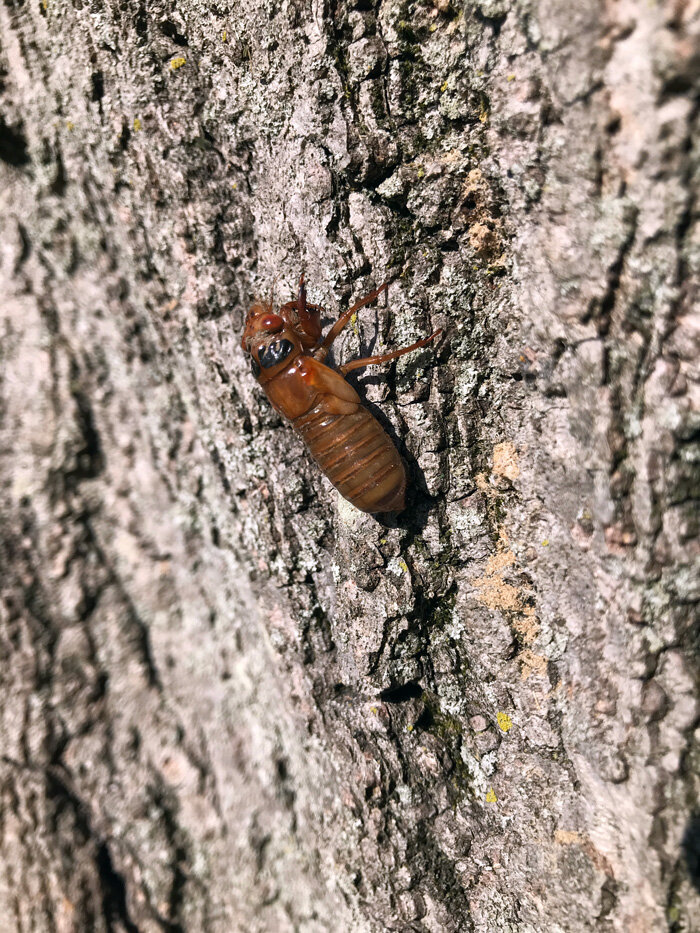This post is from guestblogger, 5cense. Original posting here.
Since Jess has been too busy giving all these interviews about eating cicadas to actually collect and cook them, I figured I'd walk the talk for her and give the practical low-down (though this advice won't be useful to anyone for another 17 years (for brood X anyway), which is crazy to think about... seriously a 4/5-times-in-a-lifetime opportunity). For the past week I've been waking up before dawn to collect cicadas, until yesterday when it got cool and rainy and seems they stopped coming out of the ground. All in all I don't think it was the biblical plague the media hyped it up to be, at least not in D.C. proper... maybe it's a different story in the suburbs? Seems the cicadas don't like "nature" and the majority I found were in grassy open areas in Rock Creek and Kalorama Park, which certainly made them easier to find. I saw some in Malcolm X park but there were tons of squirrels, birds and rats to compete with, not to mention the possibility of pesticides or rat poison. Ideally we looked for ones crawling on the ground or starting to go up trees. If I collected stationary nymphs on trees I often found that they'd molt by the time I got back and while some say the soft white adults were the best, they looked gross after being trampled to death by the active nymphs. Like lobsters and crabs (also bugs), seems it's best to collect and keep them alive as long as possible.
And here's what the ones we collected the other morning looked and sounded like:
Some also say the black adults taste good, but we never tried them... seems if an adult made it to the tree and molted then it deserves to live, especially the pregnant females which some say are a delicacy. I "saved" quite a few adult cicadas that were on sidewalks or seemingly lost nowhere near a tree by putting them high up in trees, and a few (including a stowaway that hitched a ride home on my backpack) we brought into our house and put on our plants to keep them safe until they were ready to mate, but then they flew around our house and wouldn't settle down so we put them in our backyard, where likely they were eaten by the numerous birds or squirrels that eat anything that moves in our yard. Once I'd get home I'd sort thru them to remove the grass and debris and dead ones, and also any fungus-infected "sex-crazed zombies".
Once I sorted thru them I bagged them into meal-size batches and stuck them in the freezer, which seems sort of cruel, but better then having them suffocate or slowly die. I collected about a dozen bags worth (maybe a ½ pound each). The first 2 times we tried them (including the ones Jess cooked for CNN, see the previous post), we sautéed/fried them in sesame oil w/ garlic, chili and spices. This past weekend we had a friend over for dinner and made cicada fajitas/tacos, which were tasty.
A few nights ago we wanted to try them roasted and without too much spice to really taste the bug (after all, most anything fried with garlic and chilis will taste good). As when we fried them, we boiled them first for a few minutes, which serves to clean them (and also seems to plumpen them up) and then rinsed them in a strainer to get off any remaining debris. We mixed them in with potatoes on a cookie sheet and added olive oil and a little garlic, salt, pepper and rosemary and stuck them in the oven for about 20 minutes (the potatoes for longer).
They might look gross, but must say they were quite delicious—nutty, buttery and earthy. In fact we gobbled the bugs up before the potatoes. They taste like something that's meant to be eaten, like shrimp, sea urchin or clams (which we tend to eat a lot of... the lower on the food chain the better). They supposedly have a lot of fat because once they emerge from the ground they live off their fat stores during their 2-week party of molting, courting and mating, but seems nobody has done a proper nutritional analysis, so "my better ½" Jess wants to sacrifice one of our baggies for analysis (if we don't devour them all first).



